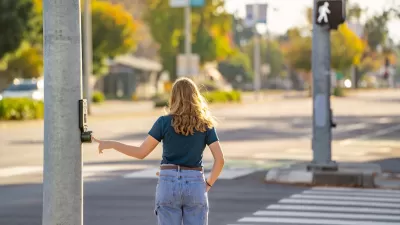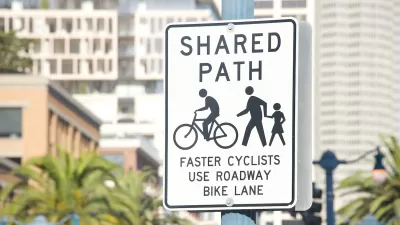A policy released by the California Department of Transportation in December will require Complete Streets elements in all state road projects.

The California Department of Transportation (Caltrans) has issued a new policy that "recognizes that streets are not only used for transportation but are also valuable community spaces," acknowledging the need to prioritize infrastructure for pedestrians, bike riders, and transit users in every Caltrans project. According to Melanie Curry, the policy solidifies the goals laid out in a prior Complete Streets plan from 2014. The new plan provides a list of "high-priority implementation actions" meant to train engineers and embed design flexibility and street safety design principles into Caltrans projects.
As Curry notes, "One thing the list reveals is that Caltrans is still taking the first steps towards truly incorporating Complete Streets into its projects, despite years of talking about it." Nevertheless, the new policy takes a stronger stance on Complete Streets elements, making them a required rather than recommended component of projects.
"The new policy states, unequivocally, that the priority of the state transportation department is 'to encourage and maximize walking, biking, transit, and passenger rail' for all kinds of reasons, including climate, health, equity, and environmental ones, as well as 'to foster socially and economically vibrant, thriving, and resilient communities.'" While Complete Streets advocates object to some of Caltrans' bike policies—such as allowing minimally protective sharrows on high-speed streets—the shift in focus could have a significant impact on how road projects across the state are designed and implemented.
FULL STORY: Caltrans Officially Embraces Complete Streets in All Projects

Alabama: Trump Terminates Settlements for Black Communities Harmed By Raw Sewage
Trump deemed the landmark civil rights agreement “illegal DEI and environmental justice policy.”

Planetizen Federal Action Tracker
A weekly monitor of how Trump’s orders and actions are impacting planners and planning in America.

The 120 Year Old Tiny Home Villages That Sheltered San Francisco’s Earthquake Refugees
More than a century ago, San Francisco mobilized to house thousands of residents displaced by the 1906 earthquake. Could their strategy offer a model for the present?

Oregon Legislature to Consider Transit Funding Laws
One proposal would increase the state’s payroll tax by .08% to fund transit agencies and expand service.

Housing Vouchers as a Key Piece of Houston’s Housing Strategy
The Houston Housing Authority supports 19,000 households through the housing voucher program.

Rural Population Grew Again in 2024
Americans continued to move to smaller towns and cities, resulting in a fourth straight year of growth in rural areas.
Urban Design for Planners 1: Software Tools
This six-course series explores essential urban design concepts using open source software and equips planners with the tools they need to participate fully in the urban design process.
Planning for Universal Design
Learn the tools for implementing Universal Design in planning regulations.
Clanton & Associates, Inc.
Jessamine County Fiscal Court
Institute for Housing and Urban Development Studies (IHS)
City of Grandview
Harvard GSD Executive Education
Toledo-Lucas County Plan Commissions
Salt Lake City
NYU Wagner Graduate School of Public Service





























